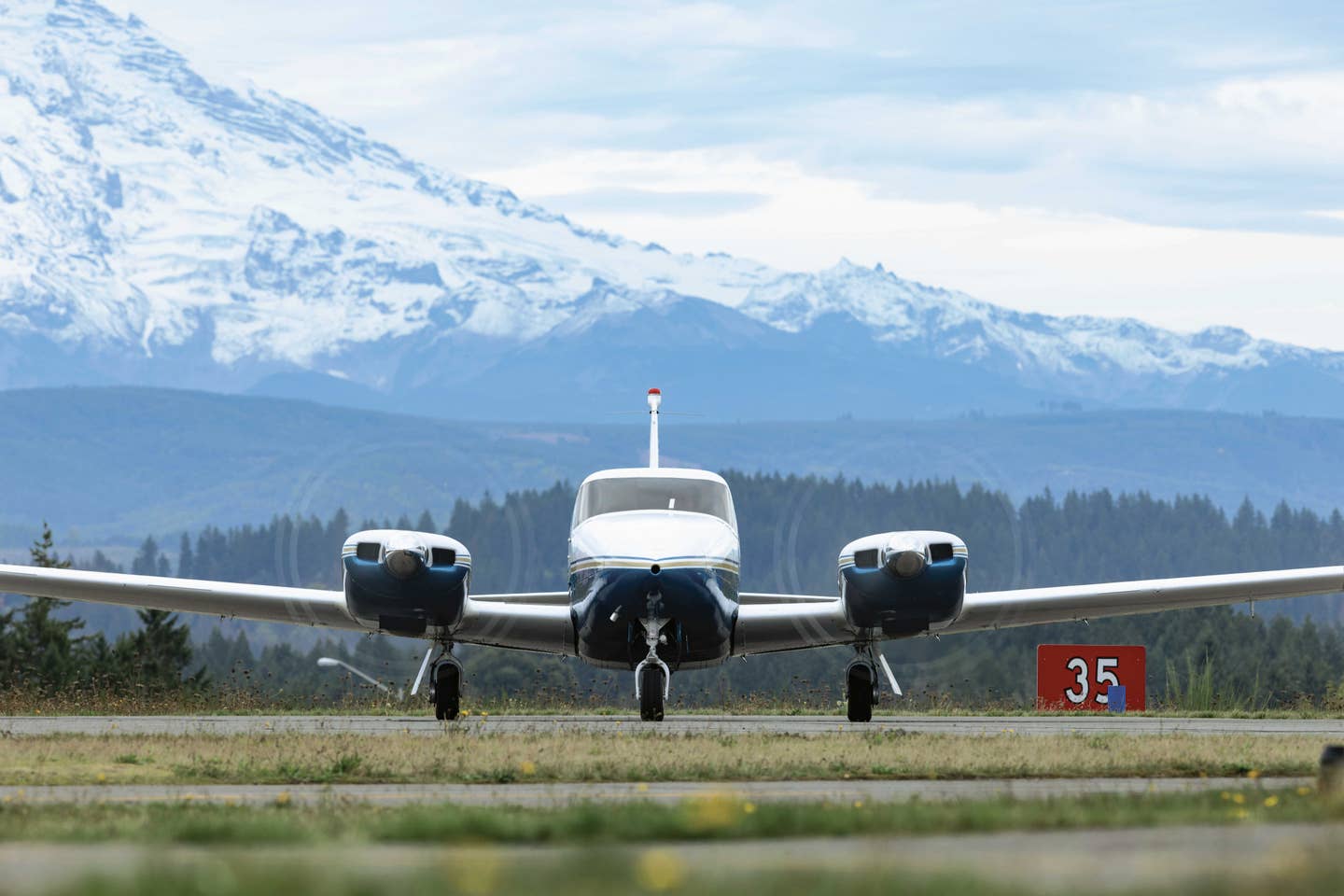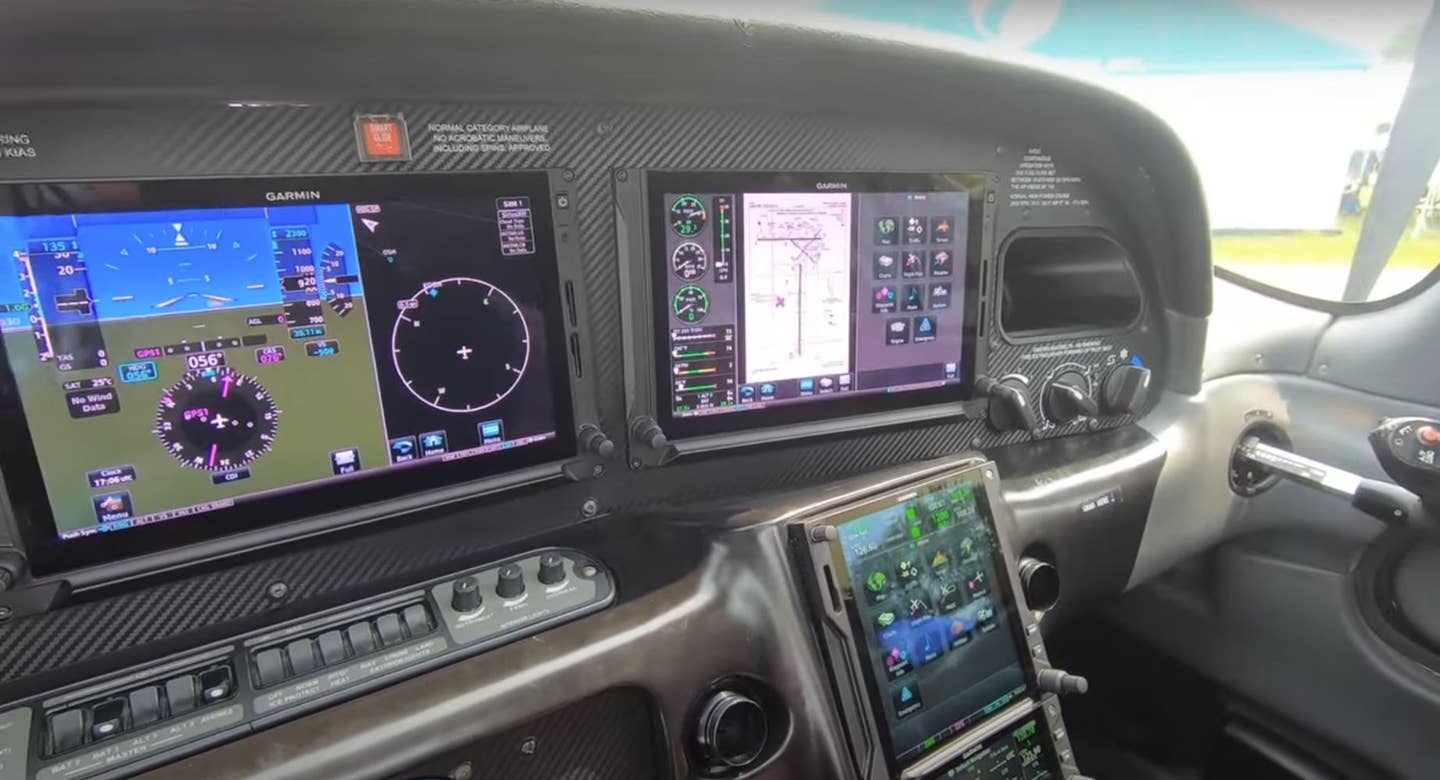Going with Glass: The Mother of All Panel Upgrades
The Boyd family gives their Piper Twin Comanche an extreme instrument makeover in Washington state.

‘I chose the Twin Comanche because I flew one back
in the 1980s, and I loved it,’ says John Boyd, an A&P and retired Boeing 737 captain from Alaska Airlines who resides in Puyallup, Washington. ‘It’s an efficient
twin and faster than the 182.’ [Jim Barrett]
A vintage aircraft, if properly maintained, will last for decades. But there may come a time you want to make changes in the name of safety and convenience. It can be a challenge, as the Boyd family from Puyallup, Washington, learned when deciding to do an extreme makeover on the panel of its 1960s-era Piper Twin Comanche, also known as the PA-30.
The Boyds are an aviation family. John Boyd is an A&P and retired Boeing 737 captain from Alaska Airlines. John’s sons, Jason, 32, and Justin, 30, both hold instructor ratings and are planning aviation careers. Jason is also an A&P. The family also owns a Cessna 182 Skylane that it flies regularly. In summer 2017, John Boyd decided it was time to get something a little more comfortable for family travel, and something for the boys to build their multiengine time in.
If you're not already a subscriber, what are you waiting for? Subscribe today to get the issue as soon as it is released in either Print or Digital formats.
Subscribe Now“I chose the Twin Comanche because I flew one back in the 1980s, and I loved it,” says Boyd. It’s an efficient twin and faster than the 182.”
The ‘Before’
N7163Y rolled out of the factory in 1963. When the Boyds acquired it, the aircraft still had most of the original panel in the original layout—the instruments were scattered, as the classic six-pack arrangement we know did not become the norm for Piper Aircraft until the late 1960s.
The original instrument installation made the airplane difficult to fly sometimes, says Jason Boyd: “I flew an IFR approach at night with that old panel, and my scan was terrible! I vowed never to do it again.”
There were other surprises from the older technology: Activation of the vintage autopilot for the first (and only) time resulted in an “unexpected flight event,” and the Boyds decided “never to turn it on again.”
Shortly after acquiring the aircraft, they began an interior restoration, replacing the brown cloth seats and side panels with cool, gray leather. The interior project spanned several years because John Boyd was still flying the line, and the boys were working full time at a local flight school.
- READ MORE: All Flight Jackets Tell a Story
The panel was not strictly 1960s, says Boyd, as it sported a 1980s-era BendixKing KNS 80 nav unit, which they replaced with a Garmin GNS 530 and flew it like that for a while, getting used to the airplane. If they ever had a question about systems or aircraft quirks, Boyd reached out to Webco Aircraft, the Comanche specialists, located in Newton, Kansas.
“They’ve seen everything,” says Boyd.
Planning for the panel upgrade was meticulous. They went through the aircraft system by system to determine what they wanted to keep and what would be replaced.
Some of the engine instruments or their components were no longer available. They learned that some of the avionics and instrument manufacturers were out of business. Other times, the cost of repair to the often 50-plus-year-old technology made them balk.
There was also the question of instrument reliability.
“The mechanical tachometers were off,” says Jason Boyd. “It made it difficult to sync up the propellers. If you tried to do it with the levers, they would be way off.”
“Finally, the last straw was the erroneous reading on the fuel gauges,” says John Boyd, noting that while no pilot truly trusts their fuel gauges, there is technology available that makes them more reliable, and therefore safer than they used to be, so the pilot has a better idea of how much time they have in the tanks.
Instrument Selection
The decision was made to remove all the analog instruments and replace them with digital. But there is so much out there to choose from, they spent several months shopping and eventually decided to delay, as they waited for Garmin to certify the GFC 500 3-axis autopilot.
“We knew they were working on it, and it was close,” says John Boyd. “I wanted them to certify it before I pulled the trigger. I even offered my airplane as a testbed, but Garmin said no thank you, we already have an airplane.”
Jason Boyd, the family techno-geek, supplied a list of the new instruments, noting his favorite item is the autopilot. “The fact I can pull an engine back in cruise and have the yaw damper hold the airplane straight and level and continue on course is, in my opinion, the ultimate in safety,” he says. “The technology makes this an airplane you can fly single-pilot IFR day or night, as long as you are ahead of the programming.”
The aircraft now sports touch screen panels, top-of-the-line nav/coms, engine monitoring systems, and backup instruments to help a pilot maintain situational awareness even if they are task saturated.
All this glass meant an overhaul of the electrical system was needed, says Boyd.
“When we first got the airplane, it had alternators with old internav voltage regulators,” Jason says. “The old over-voltage regulator was a problem, so we swapped them out for Hartzell Plane Power R1224 regulators. Now the airplane has paralleling alternators.”
Says John: “Everything was chosen for safety. I wanted redundancy and reliability.”
It wasn’t just on the inside. The exterior lighting was also upgraded. One of the first items to be replaced was the 1960s-era tail beacon, which was swapped for a Whelen beacon and Orion navs and strobes that are synced when activated.
“The shell of the rotating beacon is original to keep the aesthetic look of 1963, but the internals are updated to the Whelen/Orion LED Beacon,” says Jason.
Makeover Prep
The combination of a busy avionics shop and global supply chain challenges made for an interesting experience.
“We had to wait our turn at the shop,” says John. “We got on the waiting list at Spencer Aircraft in September of 2022.”
“And it was nearly a year before we got in,” notes Jason, adding that they spent that downtime in their hangar at Pierce County Airport-Thun Field (KPLU) not far away from Spencer preparing the twin for the new digital devices by removing the old mechanical instruments. Doing the removal themselves saved money and, according to John, made for a cleaner installation because they took out all of the unnecessary lines and wiring.
“Sometimes avionics shops simply cut the lines or wires to the old instruments and leave them there to save time,” John explains. “We had the time, so we figured why not?”
Says Jason: “I think we removed about 30 pounds from the aircraft.”
When parts arrived, the PA-30 returned to the shop. When there was a parts delay, the airplane would move back to the Boyds’ hangar. This process continued for several months.
Time to Test Fly
The aircraft was back together by October, and John and Jason took it up for flight tests. There were no surprises, they note. “But it did require a few tweaks,” says Jason.
John points out that they are making adjustments to establish a baseline for operations, such as engine temperatures, so they don’t get erroneous warnings.
“Pretty much the only thing that will keep us on the ground now is icing,” he says.
Flying the aircraft is a different experience now, says Justin Boyd, who shortly after the family purchased the airplane flew it to Iowa with his father and found it labor intensive.
“It’s almost like a different airplane,” Justin says. “The modern Garmin displays and autopilot make it a night-and-day difference from what it was.”
The senior Boyd figures they spent about $80,000 on the panel upgrade, but there is still one more element: the Beth test. Beth Boyd is John’s wife and the boys’ mother. It was because of Beth that John insisted that the aircraft be equipped with Garmin Smart Glide.
With the mere press of a button, the avionics return the wings to level flight, and the aircraft goes into a controlled descent on autopilot. This allows the pilot more time to focus on troubleshooting whatever issue there may be—a big win for safety and peace of mind.
Everything the Boyds Added to Their Panel
• G500 NXi GDU
• 1060 PFD/MFD
• G500 NXi GDU with 700L EIS
• GDL 69A SiriusXM satellite weather, music
• GTN 650 Xi GPS/nav/com 1
• GMA 345 Bluetooth audio panel
• GTX 345 transponder with dedicated ADS-B In and Out
• GNC 255A nav/com 2
• GI 275 backup electronic instrument
• Garmin GFC 500 autopilot
• GMC 507 control head
• GSA 28 Roll
• GSA 28 Pitch
• GSA 28 Pitch Trim
• GSA 28 Yaw
• Falcon angle-of-attack indicator
• DSTR-AOA-9200K with heads-up display
This column first appeared in the December 2023/Issue 944 of FLYING’s print edition.

Subscribe to Our Newsletter
Get the latest FLYING stories delivered directly to your inbox







